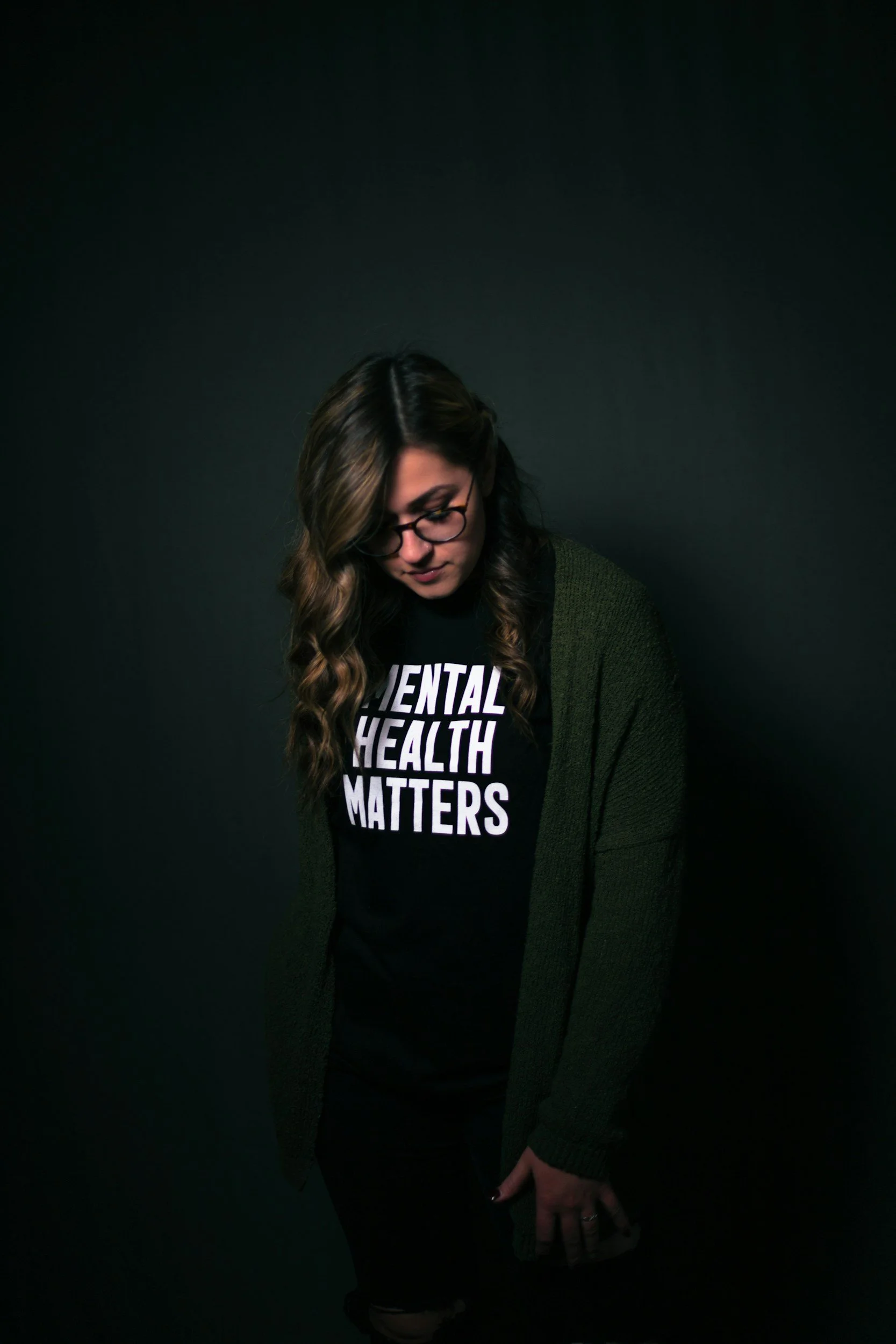
Mental Health
“Seeking mental health services can feel overwhelming, especially when you don’t know where to begin.”
-Rebecca Gastelum
What is Depression?
If you or a loved one experiences depression, you might experience:
Low mood
Irritability
Hopelessness
Poor motivation
Loss of interest in things
Difficulty sleeping and eating
In severe cases of depression, you might have thoughts of harming yourself or thoughts about death (Centers for Disease Control and Prevention, n.d.; Shevlin et al., 2021).
What is Anxiety?
If you or a loved one experiences an anxiety disorder, you might experience:
Excessive worrying about various things, including imagined scenarios
Avoiding social situations for fear of judgment
Feeling restless and/or irritable
Difficulty sleeping and eating
At times, individuals with an anxiety disorder may experience a panic attack (Centers for Disease Control and Prevention, n.d.; Shevlin et al., 2021).
You or your loved ones might be more prone to feeling depression and anxiety after a stressful life event, such as the loss of a loved one, a financial crisis, or relationship issues.
It is important for a person to consult a mental health professional if they suspect they are experiencing symptoms of depression or anxiety (Centers for Disease Control and Prevention, n.d.; Shevlin et al., 2021).
Mental Health Therapy
Watch the video below to learn about the different types of therapy!
(Berk et al., 2019; Booth, 2023; Kurzweil, 2012; Patriarca et al., 2022; Van Heemstra et al., 2024).
Studies show an evident need for mental health services in our community but there is a clear gap in access to those services.
(Ghaddar et al., 2018; Perez-Flores & Cabassa, 2021; Tambling et al., 2021).
(Andrade et al., 2019; Perez-Podrogo et al.,2024; Venner et al., 2022; Walter et al., 2019).
Substance Use in the LatinX community.
Substance use in the LatinX community presents unique challenges influenced by cultural, social, and economic factors (Venner et al., 2022).
LatinX individuals may face higher risks of substance use due to barriers such as limited access to culturally competent healthcare, language differences, and the stigma associated with seeking help (Walter et al., 2019).
Additionally, multigenerational family structures and community cultures can impact the prevalence and response to substance use (Andrade et al., 2019). Addressing these challenges requires targeted resources, bilingual education, and culturally sensitive treatment options that honor the community's values and needs (Andrade et al., 2019; Walter et al., 2019).
(Bolger & Prickett, 2021; Bucay-Harari et al., 2020; Hernandez, 2024; Nogueira & Schmidt, 2022; Villatoro et al.,2016).
Religion and Community
Religion and community play significant roles in shaping mental health experiences within the LatinX community (Bucay-Harari et al., 2020; Hernandez, 2024).
These influences can bring unique benefits and challenges for the LatinX community. Mental health issues are stigmatized or misunderstood within religious or communal contexts (Hernandez, 2024). This can discourage individuals from seeking help or openly discussing their struggles (Bolger & Prickett, 2021; Hernandez, 2024). Contrastingly, religious and community settings can also offer an optimal opportunity for collaboration and partnership to connect the LatinX community to mental health services (Bolger & Prickett, 2021; Hernandez, 2024).
It starts with a conversation….
When initiating discussions about mental health with our families, it is crucial to set aside any preconceived expectations. We must recognize that this topic can be complex for some family members. For older LatinX adults, deeply rooted stigma surrounding mental health can make these conversations particularly challenging (Jimenez et al., 2024). To prepare for these difficult discussions, it can be helpful to approach the conversation with empathy and validation of their experiences (Flores, 2022; Jimenez et al., 2024). The overall goal of fostering open conversations about mental health in LatinX households is to reduce stigma, promote clear communication, and normalize mental health discussions (Flores, 2022). This approach aims to address and alleviate the elevated rates of mental health issues within the LatinX community.
Commons Level of Care
Mental health services are available at different levels of care to meet your needs.
OUTPATIENT INDIVIDUAL AND GROUPS
Outpatient services may include individual or group psychotherapy. Individual psychotherapy provides evidence-based therapeutic services to alleviate symptoms and find support for mental health challenges (Cavelti et al., 2024).
Inpatient: Hospitalization
In some cases, mental health symptoms may require hospitalization when outpatient treatment is not enough. In California, individuals can be admitted to a psychiatric hospital voluntarily or involuntarily (Santillanes et al., 2017; Morris, 2021).
A voluntary hold allows individuals to participate in their treatment and can last from 72 hours to 14 days (Morris, 2021). Involuntary hospitalization occurs when an individual meets the criteria for hospitalization but is not willing to be admitted voluntarily (Santillanes et al., 2017; Morris, 2021).
OUTPATIENT INDIVIDUAL THERAPY SERVICES
Outpatient therapy can help manage mental health conditions, including suicidal and self-harm tendencies (Cavelti et al., 2024; Litschi et al., 2024).
Therapists can address suicidal behaviors and explore higher levels of care if needed (Litschi et al., 2024).
Outpatient mental health services also include group therapy, which can be attended alongside individual therapy or on its own (Cavelti et al., 2024).
Partial Hospitalization
The Partial Hospitalization Program (PHP) is a service that provides daily therapy without requiring you to stay in a hospital. It includes group, individual, and occupational therapies and aims to reduce the severity of mental health symptoms (Deshmukh et al., 2020; Tung et al., 2024).
Research shows it significantly reduces the likelihood of hospital admissions and leads to symptom improvements in adolescents (Deshmukh et al., 2020; Lenz et al., 2021).
OUTPATIENT GROUP THERAPY SERVICES
Group therapy involves a facilitator and multiple members meeting to work on a specific goal, such as reducing symptoms of depression. Topics can vary and may include depression, self-esteem, grief, and more (Hoskins et al., 2018).
Group therapy fosters a sense of belonging and connectedness among members. It is an effective intervention for the LatinX community, providing a supportive platform for sharing narratives and wisdom (Cumba-Aviles, 2016; Hoskins et al., 2018).
Intensive Outpatient
An intensive outpatient program (IOP) is a level of care between outpatient therapy and partial hospitalization. It involves group and individual therapy sessions 3-5 times a week (Salk et al., 2021; Van Sweringen, 2022).
You might qualify for IOP if individual therapy is not meeting your mental health needs or if your risk factors for psychiatric hospitalization are increasing.
IOP programs use a mix of somatic therapies, art therapies, and evidence-based practices. The main goal of IOP treatment is to reduce the severity of mental health symptoms and impairments so that you can move to a lower level of care (Van Sweringen, 2022).
Similar to partial hospitalization (PHP) and outpatient therapy, IOP treatment allows you to voluntarily participate and return home to your family every day after the program (Salk et al., 2021; Van Sweringen, 2022).
More Helpful Information
-
Mental health therapy is typically a 45-60-minute private session provided by a mental health professional (Schleider et a., 2020). During this time, you can talk about any presenting stressors or issues. Therapy is a safe and confidential space to express your thoughts and feelings, and learn how to cope with difficulties (Schleider et al., 2020). To learn more about therapy services, check out our video on diferent types of therapy services on our mental health page!
-
Evidence-based therapies such as Cognitive Behavioral Therapy (CBT) and Dialectical Behavioral Based Therapy (DBT) can help lessen the symptoms of depression, anxiety, and suicide (Berk et al., 2019; Patriarca et al., 2022). Many types of therapies can successfully reduce symptoms. An essential factor in your treatment success is that you feel confident and satisfied with the therapy work that you are doing (Cavelti et al., 2024).
-
If you or a loved one visits an emergency department for a mental health emergency, you will be evaluated by a mental health professional. They must make sure you are safe and not at risk of harming yourself or others (Morris, 2021). They will talk about safety and sometimes explore treatment options with you. During high-risk occasions, those treatment options will involve an immediate mental health hospitalization (Santillanes et al., 2017; Morris, 2021). To learn more about inpatient hospitalizations, please scroll to the levels of care section.
-
If you or a loved one are admitted into a mental health facility, you might be provided with a comprehensive treatment team to help you safely discharge from the facility (Santillanes et al., 2017). They can also assist you with finding mental health treatment after you discharge. There are legal time frames involved when admitted to a mental health facility (Morris, 2021). To learn more about them, pease scroll up to the levels of care segment.




